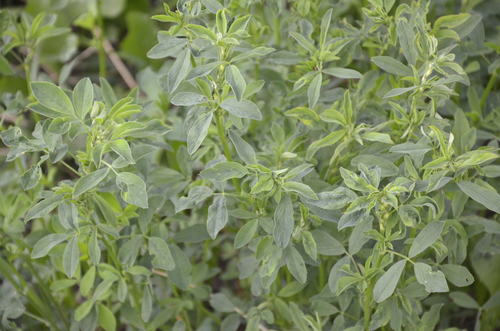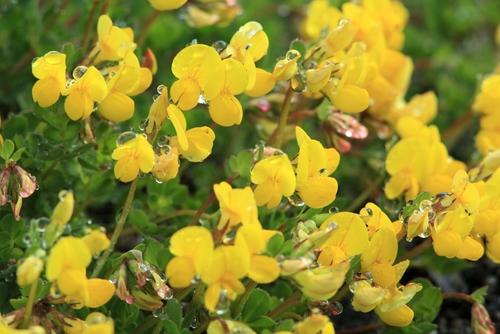



What to Choose When Reseeding Hay and Pasture Fields
Choosing grasses for your pastures and hay fields depends on the soil pH, fertility and cattle that you have.Assessing soil should be the first point of call, because whatever you chose, if pH and fertility aren't adequate for the forages you plant they will either die or never reach potential.
This is the advice of Ohio State University extension agent Chris Penrose, who is looking ahead to spring and snow thaw.

He writes that the second step is to get an idea of what you need for your livestock. For example dry beef cows probably do not need high quality alfalfa and stockers may need a higher quality and more palatable forage then what fescue grass can provide.
Other ruminants can graze pastures close so orchard grass which stores energy at the base of the plant may not be a good option if you have sheep or goats too. Poorly drained fields or fields with a lot of deer pressure are not good options for alfalfa. So what should be planted? The following is a list of common forages that can be planted throughout Ohio and the characteristics of each.
Alfalfa
It is probably the best high quality feed for livestock and as a cash crop but it requires deep, well drained soils and high fertility for high yields. While it can be used for grazing, it is best adapted for hay or silage. Be aware that it can cause bloat when grazed by livestock and purchase improved varieties with good winter hardiness, disease and potato leafhopper resistance.
Birdsfoot Trefoil
This is a deep-rooted perennial legume that is best adapted to northern areas of Ohio and Pennsylvania, but I have seen more growing in southern Ohio over the past three years. It can tolerate low pH, poor soil drainage, marginal fertility and is non-bloating. It is slow to establish, subject to weed invasion so should be planted in a mixed stand, and prone to diseases.

Red Clover
Red clover is a short lived perennial legume but has several advantages. It can tolerate poorly drained and slightly acidic soils and has good seeding vigor. Seeding vigor is important because it can stretch out or improve stands. It is a good option for frost seeding, so in the next month, we can spread this seed on pastures or hay fields. Red clover can be hard to dry for hay bloat can be a problem when grazing if there is not enough grass present.
White Clover
This is a low-growing short lived perennial, writes Mr Penrose. This is a good legume to have in pastures especially if short growing grasses like bluegrass are present. He adds that it is a good legume if sheep and goats are grazing as they tend to graze closer than cattle. This is a good plant for continuous grazing as it is a prolific seeder, but bloat can be a problem.
Kentucky Bluegrass
This grass is ideal for pastures as the low growth habit makes it tolerant to close grazing. It forms a dense sod and spreads by seeds and rhizomes. It can persist under poor soil conditions and management, but responds to good management. Yields will be less than many other cool season grasses and is more drought susceptible than other grasses.
Orchardgrass
This grass is good for pasture, hay and silage. It is very productive "bunch-type" grass that responds well to good management. It grows best in well drained soils, has rapid regrowth and is palatable. However when it becomes mature, palatability rapidly declines. Common varieties mature rapidly, so consider late maturing varieties. Rust can be a problem in latter in the summer, so select varieties with leaf disease resistance.
Ryegrass
If alfalfa is the "Queen" of forages, ryegrass is the "King". Perennial ryegrass is a bunch-type grass that is palatable with high nutritive value. It has a long growing season and excellent yields with good fertility. Why doesn't everyone grow it? It is less winter hardy than other grasses, best adapted to areas like northern Ohio, it is not as competitive as other grasses and it is difficult to dry for hay.
Fescue
The grass we love to hate. During this time of the year, it is the best grass we have. It will stockpile well for grazing during the winter and retain much of its quality. It is a high yielding grass that tolerates low fertility, drought, insects and diseases.
The problem is that common types have a fungus or endophyte in it that makes it unpalatable and can cause health problems in the summer months and pregnancy problems with horses. The good news is this is greatly reduced during the winter months and palatability increases. There are also varieties available without the endophyte or with a "novel" endophyte that will not cause problems with livestock.
Other Grass Options
There are several other grasses that have good adaptation for our area. Smooth bromegrass is high quality forage for hay and pasture and will retain quality better than other grasses when mature. The grass is adversely affected during stem elongation if cut or grazed. Reed canarygrass is a good option in flood prone areas but will grow in other areas. It is high yielding and very competitive but slow to establish. Purchase only high quality low-alkaloid varieties to increase forage quality.
Unless growing a pure stand of alfalfa, mixing types of forages for a new seeding is a good option. Consider a primary grass, a primary legume, then you can consider minor species to add to the mix. It is important to consider species with similar growth habits. For example, you would not want to plant bluegrass with red clover, but you could plant orchardgrass or fescue with red clover.
Finally, purchase only high quality improved varieties of seed. There have been tremendous advances in quality, yield, persistence, insect and disease resistance which makes the added cost of the seed a good value.


